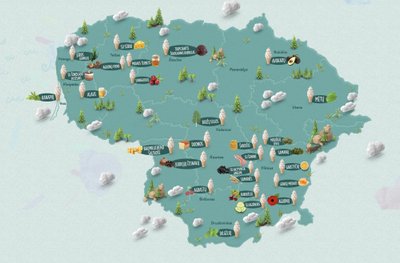“When drawing the ice-cream map, the variety of flavours offered by chefs in Vilnius, Birštonas, Telšiai, Rokiškis and other towns came as a pleasant surprise to us. Often some unusual experience, for instance an avocado- or a cold borsch-flavoured ice-cream, may prompt you to explore new places," Indrė Trakimaitė-Šeškuvienė, the Head of Products and Marketing at Lithuania Travel, said. "We hope that our ice-cream map will be useful not only for someone with a sweet tooth. It looks like September is going to be warm, so we suggest closing the ice-cream season with a difference.”
Those who are ready to take up the ice-cream challenge will find the map on the official tourism website. The stylised map features addresses of 20 restaurants and cafes and links to their websites and social media channels.
According to Trakimaitė-Šeškuvienė, the tremendous success of the GASTRO travel guide across Lithuania presented in June inspired the idea for the ice-cream map.
“The GASTRO travel guide across Lithuania became an absolute summer hit and reached a large portion of the population of Lithuania via our official tourism website Lithuania.travel, mass media and printed publications. During the Vilnius Capital Days Festival alone, over 2,000 publications were distributed, while the guide online had almost 50,000 visitors. We wish that the ice-cream map, like other planned marketing measures, would encourage Lithuanians to travel more in their own country. The domestic tourism survey showed that over a third of Lithuanians specified visiting restaurants and cafes as one of the main activities during travel," Trakimaitė-Šeškuvienė said.

The updated GASTRO travel guide across Lithuania, which has been supplemented with the dish of Ground Elder Pancakes with Duck Eggs, is also available at Lithuania Travel.
Domestic tourism in Lithuania continues to be record high. In H1 2019, 919,000 Lithuanians spent at least one night in tourist accommodation. This is 13.23% more than at the same time last year. Domestic tourists account for more than half of the country's tourism market – 55.2%. Domestic tourists spend more than a third of their travel costs on food.
